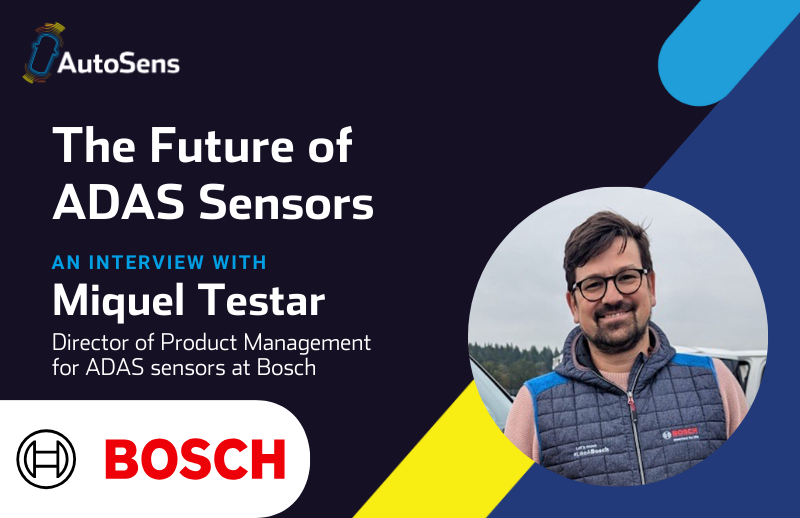
As LiDAR increasingly dominates conversations about environmental sensor hardware in the automotive market, the technology’s weaknesses – of cost, resolution and sensitivity, are stimulating a surge in innovative companies with alternate views.
One of those companies, SensL, who exhibited at the inaugural AutoSens event in 2016, join us again with an exciting new technology demonstrator at AutoSens Detroit. Their approach, of replacing the standard CMOS sensor at the heart of a typical LiDAR unit with a Silicon Photon-multiplier chip, promises to dramatically increase range and resolution.
We fired questions (using a combination of electrons and photons) at SensL’s CTO and Founder, Carl Jackson…
Can you quickly explain what’s different about the SiPM solution, and what exactly does it replace or improve upon from people might be more familiar with, in say, a CMOS chip?
The most significant difference is that the SiPM sensor itself has a high internal gain of about a million, which allows it to detect low light levels even down to single photons. This results in very high responsivity and signal to noise ratios, because the SiPM doesn’t require much in the way of external amplification.
Therefore, for ranging distances greater than a couple of meters, an SiPM will always perform better than either an APD or PIN diode (essentially the pixel of a CMOS imager). APD and PIN sensors cannot see low reflective targets beyond 20-50m, whereas an SiPM in single shot mode can see these targets at distances in excess of 100m.
How does that impact on what you can offer the vehicle perception sector – what advantages specifically can be seen?
Because the SiPM has the ability to detect single photons, it opens up the possibility to use a technique called TCSPC that identifies correlated photons in light-starved situations. This is analogous to the situation for autonomous vehicles when ranging to distant, low reflectivity objects.
The return signals may only consist of a few photons but by aggregating the results from multiple signal returns, the photons correlated with the target object can be identified. SensL has developed a LiDAR demonstrator that uses this technique, and can range objects with 5% reflectivity at very long range. This technique can also help to overcome some complex environmental situations like rain, and possible interference from the signals from other vehicles.
We see debates of “LiDAR vs camera/radar” (and no-LiDAR) – Is this still a debate and what is SensL’s view?
I think the barrier to ubiquitous LiDAR adoption is primarily the cost. Currently there is no complete solution at a practical price. It’s now well understood within the industry that LiDAR needs to be part of the fusion of sensors for a fully autonomous vehicle, along side cameras, radar and even ultrasound.
Right now, cameras and radar can provide a certain amount of ADAS functionality, and the LiDAR systems around today extend that functionality a little more. However, fully autonomous driving (and robust ADAS) will almost certainly require long range LiDAR that can work in a range of complex environments. We believe the SiPM will be the sensor technology to deliver this.
Firstly, because it’s high internal gain allows ranging to long distance and also in a range of environmental conditions, and secondly because it is based on standard CMOS processes. Therefore, SensL’s SiPM technology can offer industry-leading quality and uniformity in a volume process with compelling cost advantage.
Can you explain SensL’s business model? You are a sensor company but do you provide actual LiDAR modules or focus solely on the key sensing components?
SensL is a fabless semiconductor company and we focus exclusively on developing low light sensors that are critical components to LiDAR systems which also require beam steering and lasers.
SensL is not a module company. We do, however, develop technology demonstration hardware that we use with the industry to show, at detailed technical levels, how an SiPM sensor compares to APD and pin-diode sensors when used in long distance applications. By developing our demonstration hardware we can validate our software models and when customers have specific requirements we can show them exactly how and SiPM will perform in their configuration.
Solid State LiDAR design considerations
Can you give us a sense of your product roadmap and any new developments you plan to share at the upcoming AutoSens conferences?
Our R-Series SiPM is sampling and we are achieving 8.5% PDE at 905nm which is truly leading edge performance. At AutoSens in Detroit we will also be showing images from our latest hardware proof of concept demonstrator using a new 1×16 SiPM array in a scanning system identifying low reflective targets at >150m.
Tell us about the INSPEX project
INSPEX is an interesting project that was funded by the European Union’s Horizon 2020 research and innovation program. Its focus is to apply the advances that have been developed in the autonomous driving field and apply it to the field of smart mobility, for example, assistive guidance for the visually impaired. This requires miniaturizing the technology and reducing its power so that it can be portable or wearable.
As a demonstrator the INSPEX partners have chosen to focus on obstacle detection for the visually impaired and blind with the objective of integrating the INSPEX system into a standard white cane. This will allow the cane to detect various kinds of obstacles and alert the user of their location using 3D spatial audio feedback.
Additional details are in this EETimes article.
Are there any other crossovers for sensors used in ADAS and autonomous vehicles, or vice versa, such as health, hazardous environments, etc?
Yes, a great deal. They all require photodetectors with high sensitivity and low noise, and with good timing properties. For the first 10 years of SensL’s existence we were primarily engaged with applications in the medical imaging and hazard and threat fields. These applications typically use a crystal called a scintillator to convert gamma or X-ray radiation into a flash of visible photons.
The scintillator is coupled to a photodetector to measure the visible photons. Until SensL commercialized the SiPM, the photodetector of choice was the PMT (Photomultiplier Tube), which is a vacuum tube that is fragile, affected by magnetic fields, requires 1kV of bias and suffers from non-uniformities. The SiPM overcomes all of these practical issues, while matching the PMTs performance capabilities. The commercial availability of the SiPM has really changed the landscape of medical applications such as PET imaging, and portable personal radiation monitors in the field of hazard and threat detection.
Also beyond ADAS and autonomous driving using LiDAR we are also seeing increasing activity to use SiPM’s in place of APD’s in augmented reality and virtual reality platforms as well as robotics, smart factories, and for presence detection in IoT applications.
This is your second AutoSens, what are you looking forward to?
Carl Jackson presenting at AutoSens 2016
We are looking forward to seeing the progress being made in all of the different fields of ADAS, and see how they are all starting to come together to make further ADAS functionality a reality. We are also looking forward to showing the progress we have made with our LiDAR sensors and demonstrator systems.
I think the industry is very interested in understanding how to achieve the really challenging objective of identifying low reflective targets at long distances in a cost effective way. These kinds of events where we can share our experiences in studying this design challenge are important to us and the industry.
You’re a growing company, what are you looking for in new recruits?
SensL is a profitable and growing company and we are investing heavily in products for the LiDAR market. Our engineering team is growing rapidly and we are adding personnel in everything from application testing to optics, CMOS process, and Analog engineering.
I’d encourage readers interested to learn more by visiting our recruiting website.
[su_button url=”https://auto-sens.com/agenda-detroit/” style=”soft” background=”#2d8bef” size=”8″ icon=”icon: calendar”]View the Agenda[/su_button]
[su_button url=”https://auto-sens.com/register-detroit/” style=”soft” background=”#2d8bef” size=”8″ icon=”icon: calendar”]Book your tickets to AutoSens Detroit to see SensL[/su_button]






